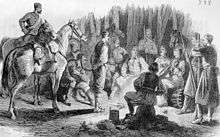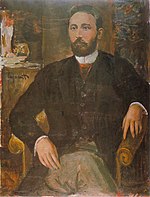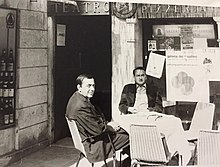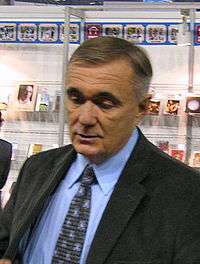Serbian literature
Serbian literature (Serbian Cyrillic: Српска књижевност), refers to literature written in Serbian language and/or in Serbia and all other lands where Serbs reside.
| Part of a series on the |
| Culture of Serbia |
|---|
 |
| People |
|
Traditions
|
|
Mythology and folklore
|
| Cuisine |
| Festivals |
|
Art
|
|
Literature
|
|
Media |
| Sport |
|
Monuments
|
|
Organisations |
|
The history of Serbian literature begins with the independent works from the Nemanjić dynasty era. With the fall of Serbia and neighboring countries in the 15th century, there is a gap in the literary history in the occupied land. Serbian literature continued uninterrupted in lands under European rule and saw a revival and Baroque works published in the 18th century in what is today Vojvodina. Serbia gained independence following the Serbian Revolution (1804–1815) and Serbian literature has since prospered and several Serbian writers went on to achieve international fame.
History
Medieval and post-medieval literature

- Medieval
The Old Church Slavonic literature was created based on the Byzantine model, and at first church services and biblical texts were translated into Slavic, and soon afterward other works about Christian life values (including Latin works) from which they attained necessary knowledge in various fields. Although this Christian literature educated the Slavs, it did not have an overwhelming influence on original works. Instead, a more narrow aspect, the genres, and poetics with which the cult of saints could be celebrated were used, owing to the Slavic celebration of Cyril and Methodius and their Slav disciples as saints and those responsible for Slavic literacy. The ritual genres were hagiographies, homiletics and hymnography, known in Slavic as žitije (vita), pohvala (eulogy), službe (church services), effectively meaning prose, rhetoric, and poetry. The fact that the first Slavic works were in the canonical form of ritual literature, and that the literary language was the ritual Slavic language, defined the further development. Medieval Slavic literature, especially Serbian, was modeled on this classical Slavic literature. The new themes in Serbian literature were all created within the classic ritual genres.[1]
Serbian medieval literature is very rich with the total of around 500 separate genres. Medieval works are mostly a mix of history, law theory, theology, writing, philology.[2] While there are several works of poetry written in the Serbian literature of the middle ages, there are only few dramas and published novels were mostly adaptations and translations.[3] The earliest writings in Serbian were religious in nature. Religions were historically the first institutions that persisted despite political and military upheavals, as well as the first organizations to see the value in writing down their history and policies. Serbia's early religious documents date back as we know to the 10th and 11th centuries. In the 12th century the art form of religious writing was developed by Saint Sava, who worked to bring about an artistic aspect to these writings, also based on earlier works.
Notable medieval authors include Saint Sava, Jefimija, Stefan Lazarević, Constantine of Kostenets and others.[4]
This period has produces several great works and authors who have since became classics of the national literature.[5]
Medieval literature has also influenced a number of modern poets, such as Desanka Maksimović, Miodrag Pavlović, Vasko Popa, Matija Bećković.[2]
- Post-medieval

Post-medieval Serbian literature was dominated by folk songs and epics passed orally from generation to generation. Historic events, such as the Battle of Kosovo in the 14th century play a major role in the development of the Serbian epic poetry.
Works of epic poetry are considered to be the best when it comes to Serbian folk literature and epic poetry is also a key component when it comes to National consciousness, identity and mentality.[7] The influence of epic poetry continued even after the works were written down and printed. Noted gusle players and authors of epic poetry are old Milija, old man Raško, blind Živana, Tešan Podrugović, blind Jeca and others.[8]
The oldest known, entirely fictional poems, make up the Non-historic cycle; this one is followed by poems inspired by events before, during and after Kosovo Battle. The special cycles are dedicated to Serbian legendary hero, Marko Kraljević, then about hajduks and uskoks, and the last one dedicated to the liberation of Serbia in the 19th century. Some of the best known folk ballads are The Death of the Mother of the Jugović Family and The Mourning Song of the Noble Wife of the Asan Aga (1646), translated into European languages by Goethe, Walter Scott, Pushkin and Mérimée. One of the most notable tales from Serbian folklore is The Nine Peahens and the Golden Apples.[9]
During the period of Ottoman occupation of Serbia, several printing houses were active,[10] such as Crnojević printing house, Vuković printing house, Goražde printing house, Belgrade printing house and several other, mostly active outside modern-day Serbia and in Venice. These printing houses and individual publishers were the only sources of books in Serbian during the period without the national state.
Baroque, Enlightenment and Classicism
Serbian literature in Vojvodina continued building onto Medieval tradition,[11] influenced by Old Serbian, Russian baroque, which culminated in the Slavonic-Serbian language. Baroque has an important place in the Serbian literature as it reestablished the literature and made it prominent again, which was interrupted by the Ottoman invasion.[12]
Notable Baroque writer from this period is Gavril Stefanović Venclović who wrote numerous work in several genres and started an early language reform.[5] Other most important authors of the time are Dimitrije Ljubavić, Đorđe Branković, Andrija Zmajević, Vasilije III Petrović-Njegoš, Mojsije Putnik, Pavle Julinac, Jovan Rajić, Zaharije Orfelin Simeon Piščević, Gerasim Zelić and others.[13][14][15]
Having no institutions of their own during the foreign occupation, Serbs invited Russian authors and educators to help with the education of the nation. The influx of Russian authors made poems more prominent, rather than prose writing. Drama and theatre life were started as well. A gymnasium in modern-day Sremski Karlovci was a center of culture for several years in the 18th century, headed by Emanuel Kozačinski who wrote a notable Baroque work Traedokomedija in 1734.[15]
During Enlightenment a new cultural model was formed, accompanied with the historical reforms undertaken by Maria Theresa.[16] Authors of the age of Enlightenment include Dositej Obradović, Atanasije Stojković, Jevstatije Mihajlović, Atanasije Nikolić, Vasilije Čokrljan. Serbian age of Enlightenment did not produce a work of note on the European scale. The most important work of this period is considered to be Život i priključenija by Dositej Obradović.[17]
Classicism was introduced with the poems of Aleksije Vezilić, who also advocated the core values of the age of Enlightment.[18] The most notable dramatist of the period was Jovan Sterija Popović, although his works also contain elements of Romanticism[19] while the best-known Serbian classicist poet and the founder of the first Serbian poetry movement[18] was Lukijan Mušicki.[20]
Romanticism and Realism


Right: Petar Kočić was a Realist writer and activist
Before the start of a fully established Romanticism concomitant with the Revolutions of 1848, some Romanticist ideas (e.g. the usage of national language to rally for national unification of all classes) were developing, especially among monastic clergy in Vojvodina.
After winning the independence from the Ottoman Empire, the Serbian independence movement sparked the first works of modern Serbian literature. Most notably Petar II Petrović Njegoš and his Mountain Wreath of 1847, represent a cornerstone of the Serbian epic, which was based on the rhythms of the Serbian epic poetry and the works by Homer.[21]
Vuk Stefanović Karadžić, an acquaintance of J. W. von Goethe and Leopold von Ranke,[22] became the first person to collect folk songs and epics and to publish them in a book. Vuk Karadžić is regarded as the premier Serbian philologist, who together with Đuro Daničić[23] played a major role in reforming the modern Serbian language and alphabet. Following the language reformes made by Vuk, several authors like Sima Milutinović Sarajlija and Matija Nenadović published their works which went on to influence other authors.[22]
Branko Radičević was the initiator of Romantic poetry. He rejected the classicist norms, objectivism and focused on expressing the direct experience and feelings in his art.[24] Poems Đački rastanak and Tuga i opomena are considered to be his best works.[24]
Other noteworthy Romantic authors include Jovan Grčić Milenko, Kosta Trifković, king Nicholas I of Montenegro and Jovan Ilić.[25]
Romanticism is of great importance to the Serbian literature considering that the authors of the epoch have started using the newly reformed Serbian language and managed to write several works which are considered to be the masterpieces of the Serbian literature, such as Đulići uveoci and poetry for children by Jovan Jovanović Zmaj, Santa Maria della Salute by Laza Kostić and several poems by Đura Jakšić.[26]
Travelogues by Ljubomir Nenadović introduced a new literary form which emerged in the 19th century.[27]
The main themes of realists were the country's social groups and classes, the differences between urban and rural population and exploration of various types of charachters.[28]
Realism started developing alongside romanticism, as Jakov Iganjtović and Stefan Mitrov Ljubiša published their works.[29]
Svetozar Ćorović depicted his native Herzegovina, where the shift in the Moslem population during the Bosnian crisis and after was most acute. Simo Matavulj and Ivo Ćipiko[30] penned a landscape of the south Adriatic not always sunny and blue. Ćipiko's lyrical writings warned the reader of the deteriorating social conditions, especially The Spiders. Notable realistic authors are also Janko Veselinović, Laza Lazarević, Milovan Glišić, Stevan Sremac, Radoje Domanović, Svetolik Ranković,[31] Veljko M. Milićević, and Borisav Stanković with his major works, Nečista krv (Impure Blood) and Koštana (drama). Impure Blood is now considered one of the most powerful Serbian novels of the period. based in the world of the town of Vranje. This place of merchants and landowners was on its way out together with the retreating Turks from the region, after the long struggle for Old Serbia from 1903-1911 and the Balkan Wars. Petar Kočić is well-known for highly lyrical prose and the quest for the independence of Bosnia and Herzegovina and its unification with Serbia. In Kočić's play "The Badger Before the Court", the Austro-Hungarian authorities are mocked for their proclivity to rule over other nations.
The legacy of Ragusan literature influenced Serbian literature, especially thanks to the members of the Serb-Catholic movement in Dubrovnik, such as Matija Ban, Vid Vuletić Vukasović and Ivo Vojnović.[32][33]
The only notable poet of the period was Vojislav Ilić. His poems are not purely realistic but mostly post-romantic, although they share several important elements with other realist works.[31]
Chief comedy and drama author was Branislav Nušić, who enjoyed popularity in Serbia and the wider region.[34]
New literary genres were explored in this period. Lazar Komarčić became a pioneer SF writer.[35]
Modern literature

The literary trend of the first and second decade of the 20th century is referred to as Moderna in Serbian. Its influences came from leading literature movements in Europe, particularly that of symbolism and the psychological novel, but more through mood and aesthetic component rather than of literary craftsmanship. It was manifested in the works of Jovan Dučić and Milan Rakić, the two poet diplomats. The third leading poet at the time was Aleksa Šantić whose poetry was less subtle but filled with pathos, emotion, and sincerity. They were popular for their patriotic, romantic and social overtones.[36]
According to literary historian Petar Milošević, Serbian moderna has produced several masterful poems, chiefly authored by Vladislav Petković Dis, Jovan Dučić, Milan Rakić, Sima Pandurović and the first half of Milutin Bojić's "Ode to a Blue Sea Tomb".[37]
Other poets such as Veljko Petrović, Milutin Bojić, Milutin Uskoković, Sima Pandurović, Vladislav Petković Dis, Milorad Mitrović, Vladimir Stanimirović, Danica Marković, Velimir Rajić, Milorad Pavlović-Krpa, Milan Ćurčin, Milorad Petrović Seljančica, all took different paths and showed great sophistication and advancement not only in their craft but in their world view as well. Most of them were pessimistic in their outlook, while at the same time patriotic in the wake of turbulent events that were then culminating in the struggle for Old Serbia, the Balkan Wars and World War I.
All these writers were backed by Serbian critics educated in the West. For example, Bogdan Popović, Pavle Popović, Ljubomir Nedić, Slobodan Jovanović, Branko Lazarević, Vojislav Jovanović Marambo and Jovan Skerlić. Skerlić with his chef-d'oeuvre, the historical survey of Serbian literature, and Bogdan Popović, with his refined, Western-schooled aestheticism, not only weighed the writers’ achievements but also pointed out the directions of modern world literature to them.
In the 20th century, Serbian literature flourished and a myriad of young and talented writers appeared.
Jelena Dimitrijević and Isidora Sekulić are two early twentieth century women writers. Sekulić mostly wrote essays, which were the best in the Serbian literature of the time.[38]
During the Interwar period a number of new literary movements, styles and ideas emerged.[38] Miloš Crnjanski led the movement called Sumatraism, Hypnotism was headed by Rade Drainac and the international movement Zenitism was started by Ljubomir Micić.[39]
Surrealism lasted for 10 years in Serbian literature with "Belgrade group" being the leading literary group of the period, headed by Marko Ristić and Koča Popović.[40] Stanislav Vinaver was a noted journalist, polyhostor and author of the avant-garde.[41] Rastko Petrović and Momčilo Nastasijević are considered to be the most notable avant-garde authors.[42]
The most well known authors are Ivo Andrić (he was awarded the Nobel Prize in Literature in 1961),[43] Miloš Crnjanski,[43] Meša Selimović, Vladan Desnica, Oskar Davičo,[42] Borislav Pekić, Branko Miljković, Danilo Kiš, Milorad Pavić, David Albahari, Miodrag Bulatović,[43] Radomir Konstantinović,[43] Mihailo Lalić,[43] Branko Ćopić,[43] Igor Marojević, Miroslav Josić Višnjić, Dobrica Ćosić,[43] and many others.
Ivo Andrić created a great opus with works mostly set in his native Bosnia and Herzegovina. Crnjanski was an accoplished poet and prose writer. His works like Lament Over Belgrade, Migrations, A novel of London are considered to be the crowning achievements of the Serbian XX century literature.[42]
The most beloved face of Serbian literature was Desanka Maksimović, who for seven decades remained the leading lady of Yugoslav poetry.[44][45][46][47][48]
Socialist realism was dominant in the period 1945-1948.[43] In comparison with other communist states Yugoslavia dogmatic form of Socialist realism were shortlived. Several authors of the Serbian literature dealt with more complexities of life and the society and its morals during the Communist period. Some of the notable authors include Antonije Isaković, Mihailo Lalić, Meša Selimović, Milovan Đilas, Branko Ćopić and Dobrica Ćosić.[49]
Starting with the 1970s there was a wave of experimental works, "trick novels" and "found manuscripts". These works were published by Milorad Pavić, Borislav Pekić, Danilo Kiš, Slobodan Selenić, Svetislav Basara, Boško Petrović, Dragan Velikić and Dobrica Ćosić.[50]
Miodrag Pavlović was one of the most prominent authors of the World literature in the XX century.[51]
After the death of Josip Broz Tito and the start of a crisis in Yugoslavia, Goli Otok became a new subject in literature. Vanredna linija by Čedo Vulević (1990) and Goli Otok by Dragoslav Mihailović were the prominent works dealing with the topic of Goli otok, which was previously deemed undesirable and controversial as a theme.[49]
Milorad Pavić is one of the most widely acclaimed Serbian author, most notably for his Dictionary of the Khazars (Хазарски речник / Hazarski rečnik), which has been translated into 38 languages.[52]
Contemporary

Dušan Kovačević and Biljana Srbljanović are noted contemporary dramatists.[53]
Ljubomir Simović is one of the chief poets of the second half of the 20th century and early 21st century.[54]
Svetlana Velmar-Janković, Grozdana Olujić and Gordana Kuić are the best known female writers in Serbia today.
Some of the most notable authors includes Zoran Živković, Vladimir Arsenijević, Vladislav Bajac, Igor Marojević and Svetislav Basara. Žiković's works have been translated to 20 languages[55] and he was awarded World Fantasy Award.
Notable works
- English translations
- Pekić, Borislav, The Time of Miracles, translated by Lovett F. Edwards, Houghton Mifflin Harcourt, 1976
- Andrić, Ivo, The Bridge on the Drina, The University of Chicago Press, 1977
- Pekić, Borislav, The Houses of Belgrade, translated by Bernard Johnson, Houghton Mifflin Harcourt, 1978
- Kiš, Danilo, A Tomb for Boris Davidovich, translated by Duska Mikic-Mitchell, Penguin Books, 1980
- Kiš, Danilo, The Encyclopedia of the Dead, translated by Michael Henry Heim, 1983
- Andrić, Ivo, Damned Yard and Other Stories , edited and translated by Celia Hawkesworth, Dufour Editions, 1992
- Selimović, Meša, Death and the Dervish, translated by Bogdan Rakic and Stephen M. Dickey, Northwestern University Press, 1996
- Pekić, Borislav, How to Quiet a Vampir: A Sotie (Writings from an Unbound Europe), translated by Stephen M. Dickey and Bogdan Rakic, Northwestern University Press, 2005
- Andrić, Ivo, The Days of the Consuls, translated by Celia Hawkesworth, Dereta, 2008
- Bajac, Vladislav. Hamam Balkania, translated by Randall A. Major, Geopoetica Publishing, 2009
- Andrić, Ivo, The Slave Girl and Other Stories, edited and translated by Radmila Gorup, Central European University Press, 2009
Citations
- Marinković 1995.
- Milošević 2010, p. 104.
- Milošević 2010, p. 105.
- "Stara književnost" (in Serbian). rastko.rs. Retrieved 20 March 2013.
- Milošević 2010, p. 103.
- Milošević-Đorđević, Nada (1995). "The oral tradition". The history of Serbian Culture. Rastko.CS1 maint: ref=harv (link)
- Bracewell, Wendy (2003). "The Proud Name of Hadjaks". In Norman M. Naimarkan=Holly Case (ed.). Yugoslavia and Its Historians: Understanding the Balkan Wars of the 1990s. Stanford University Press. pp. 25–. ISBN 978-0-8047-8029-2.
- Milošević 2010, p. 252–253.
- Volksmärchen der Serben: Der goldene Apfelbaum und die neun Pfauinnen, on zeno.org.
- Deretić 2005, p. 155.
- Deretić 2005, p. 207.
- Milošević 2010, p. 125.
- Milošević 2010, p. 125–126.
- "Od stare k novoj književnosti (Barokne tendencije)" (in Serbian). rastko.rs. Retrieved 4 August 2020.
- Deretić 2005, p. 212.
- Deretić 2005, p. 213.
- Milošević 2010, p. 191–192.
- Deretić 2005, p. 248.
- "Prosvećenost i počeci nove književnosti" (in Serbian). rastko.rs. Retrieved 20 March 2013.
- Deretić 2005, p. 218.
- Deretić 2005, p. 252.
- Deretić 2005, p. 250.
- "Стара српска књижевност - ИСТОРИЈСКА БИБЛИОТЕКА". www.istorijskabiblioteka.com. Retrieved 2020-08-05.
- Deretić 2005, p. 264.
- Milošević 2010, p. 265, 267.
- Milošević 2010, p. 442.
- Milošević 2010, p. 265.
- Milošević 2010, p. 508.
- Milošević 2010, p. 287.
- Milošević 2010, p. 507.
- Milošević 2010, p. 289.
- "Među Lavom i Drokunom". Vreme. Retrieved 28 April 2020.CS1 maint: ref=harv (link)
- Slavko, Petaković (2013). The idea of "brava dubrovačka" in the traditional epic poems. Prilozi za knjizevnost, jezik, istoriju i folklor. p. 31-46. ISBN 9781108060998.
- Milošević 2010, p. 290.
- "Lazar Komarčić, srpski sf pisac". static.astronomija.org.rs. Retrieved 2020-08-05.
- Deretić 2005, p. 303.
- Milošević 2010, p. 544.
- Deretić 2005, p. 304.
- Deretić 2005, p. 322.
- Milošević 2010, p. 606.
- Milošević 2010, p. 577.
- Deretić 2005, p. 323.
- Milošević 2010, p. 638.
- Deliso 2009, p. 110.
- Vidan 2016, p. 494.
- Hawkesworth 2000, p. 15.
- Hawkesworth 2000, p. 203.
- Juraga 2002, p. 204.
- Milošević 2010, p. 632.
- Milošević 2010, p. 780.
- Milošević 2010, p. 673.
- "Dictionary of the Khazars – Милорад Павић". www.khazars.com. Retrieved 2019-04-26.
- Milošević 2010, p. 722.
- Milošević 2010, p. 723.
- "Prof. dr Zoran Živković: ,,Nisam rekao poslednju proznu reč" – Tvoj Magazin" (in Bosnian). Retrieved 2020-08-05.
References
- Marinković, Radmila (1995). "Medieval literature". The history of Serbian Culture. Rastko.
- Deretić, Jovan (2005). Kulturna istorija Srba. Narodna knjiga.
- Milošević, Petar (2010). Storija srpske književnosti. Belgrade: Službeni glasnik. ISBN 978-86-519-0448-9.
Further reading
- Kadić, Ante (1964). Contemporary Serbian Literature. Mouton.
- Pavlović, Dragoljub (1968). Iz naše književnosti feudalnog doba (in Serbian). Prosveta,.CS1 maint: extra punctuation (link)
- Medaković, Dejan (1971). Putevi srpskog baroka (in Serbian). Nolit,.CS1 maint: extra punctuation (link)
- Palavestra, Predrag (1972). Posleratna srpska književnost 1945-1970 (in Serbian). Prosveta,.CS1 maint: extra punctuation (link)
- Vitošević, Dragiša (1975). Srpsko pesništvo: 1901-1914: razdoblje, razvoj, obeležja (in Serbian). Vuk Karadžić.
- Kašanin, Milan (1975). Srpska književnost u srednjem veku. Prosveta.
- Pavić, Milorad (1970). Istorija srpske knjiz̆evnosti baroknog doba: (XVII i XVIII vek). Nolit.
- Pavić, Milorad (1979). Istorija srpske književnosti klasicizma i predromantizma: klasicizam (in Serbian). Nolit.
- Desnica, Gojko (1983). Književnost srpskog naroda 1170-1940. Zajednica pisaca.
- Deretić, Jovan (1983). Istorija srpske književnosti. Nolit.
- Vučković, Radovan (1984). Avangardna poezija (in Serbian). Glas.
- Sekulić, Isidora (1985). Njegošu: knjiga duboke odanosti (in Serbian). Jugoslavijapublik.
- Palavestra, Predrag (1985). Srpski Simbolizam: Tipoloska Proucavanja. Srpska Aakademija Nauka i Umetnosti.
- Palavestra, Predrag (1986). Istorija moderne srpske književnosti: Zlatno doba 1892–1918. Srpska književna zadruge.
- Palavestra, Predrag (1989). New Serbian literature and criticism of ideology (in Serbian). Srpska akademija nauka i umetnosti.
- Konstantinović, Zoran (1993). Komparativno viđenje srpske književnosti. Svetovi. ISBN 978-86-7047-206-8.
- Ivić, Pavle, ed. (1995). The History of Serbian Culture. Edgware: Porthill Publishers.CS1 maint: ref=harv (link)
- Deretić, Jovan (1995). "Literature in the Eighteenth and Nineteenth centuries". The history of Serbian Culture. Rastko.
- Petković, Novica (1995). "Twentieth century literature". The history of Serbian Culture. Rastko.
- Radulović, Milan (1995). Klasici srpskog modernizma (in Serbian). Institut za književnost i umetnost.
- Deretić, Jovan (1996). Put srpske književnosti: identitet, granice, težnje. Srpska književna zadruga.
- Kojen, Leon (1996). Studije o srpskom stihu (in Serbian). Izdavačka knjižarnica Zorana Stojanovića.
- Popović, Pavle (1999). Predgled srpske književnosti. Zavod za udžbenike i nastavna sredstva. ISBN 978-86-17-07491-1.
- Pavlović, Miodrag (2000). Eseji o srpskim pesnicima. Prosveta.
- Kleut, Marija (2001). Srpska narodna književnost. Izdavčka knjižara Zorana Sojanovića.
- Živković, Dragiša (2004). Srpska književnost u evropskom okviru. Srpska književna zadruga.
- Popovic, Miodrag. Istorija Srpske knjizevnosti: romantizam. Zavod za udzbenike i nastavna sredstva.
External links
| Wikimedia Commons has media related to Serbian literature. |
| Wikisource has original text related to this article: |
